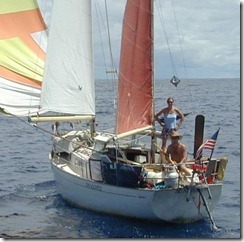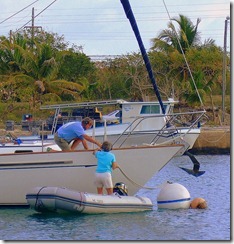 I’ve been thinking quite a lot about captains lately – what it means to be one, what it means to have one.
I’ve been thinking quite a lot about captains lately – what it means to be one, what it means to have one.
Traditional navies have formal command chains with authority and responsibility concentrated at the top while grunt labor supports from the bottom. But the relatively small crews aboard cruising boats make for a pretty short hierarchy. No matter what you call yourselves aboard your boat, decision-making and responsibility…not to mention physical work… is distributed much more equitably.
Traditional systems
The majority of the Admirals, regardless of how their lives were arranged on shore, say they have a traditional system of having only one captain on the boat. (I didn’t, but more on that later.)
 It may have been an adjustment for them, but such an arrangement certainly makes sense when one partner has significantly more experience than the other, such as for Sheri aboard Procyon with her retired Coast Guard husband, for Janna aboard Dragonfly for their honeymoon voyage across the Pacific, or for Kathleen of Renaissance who, like many, came aboard to share a partner’s cruising dream.
It may have been an adjustment for them, but such an arrangement certainly makes sense when one partner has significantly more experience than the other, such as for Sheri aboard Procyon with her retired Coast Guard husband, for Janna aboard Dragonfly for their honeymoon voyage across the Pacific, or for Kathleen of Renaissance who, like many, came aboard to share a partner’s cruising dream.
Of course, on more boats than you might think, it’s the woman who has more experience and is the official captain.
Co-captains
An alternative is to have co-captains. This plan can encounter some resistance, sometimes based on male ego, but sometimes based on practicality.
 Lisa of Lady Galadriel says, “When we first set out, I thought we should ‘co-captain’ – the way that in other areas of our lives we’ve been partners – and discuss and negotiate major issues. But Dennis was against the co-captain idea in the concern that, should something go seriously wrong, it was important to have one person giving directions and the other following without discussion.” In sailing, there certainly are those times.
Lisa of Lady Galadriel says, “When we first set out, I thought we should ‘co-captain’ – the way that in other areas of our lives we’ve been partners – and discuss and negotiate major issues. But Dennis was against the co-captain idea in the concern that, should something go seriously wrong, it was important to have one person giving directions and the other following without discussion.” In sailing, there certainly are those times.
As miles pass beneath the keel for these women, some settle in and are content not to shoulder the ultimate responsibility, while others, carve out areas of authority for themselves by, as Jane of Lionheart recounts, “up-skilling” on areas they believe they can excel in. Often it’s merely a matter of absorbing experience and gaining the confidence to make their opinions heard. In this way, the distinction between captain and mate blurs, and the de facto situation ends up much as Lisa imagined it.
However, many cruising couples set out with a fairly equal amount of experience…or inexperience. Regardless of who gets called captain, these pairs are more likely to work out a system of shared responsibility from the start. The expression that recurs repeatedly in their explanations is “taking the lead.” He “takes the lead in sail management,” for example, while she “takes the lead” in planning and navigation. In this way they work out a jigsaw puzzle of responsibility, each partner “taking the lead” in a particular area with room for the other to put in his or her opinion or negotiate a compromise. The result is both feel decisions have been made jointly. That’s how it has worked for Suzanne and John of Zeelander, now 75 and still sailing after two boats and a circumnavigation.
Negotiating compromises
Negotiating compromises between a strong-minded captain and mate can benefit from some delicacy.
 “I often find myself nagging about reefing or changing plans when the wind pipes up,” says Judy of Ursa Minor. “Sometimes it gets fairly heated before he agrees, so I have learned more tactful ways to negotiate. If we’re sailing with a second reef in and the wind drops considerably, he’ll say, ‘let’s shake out the reef’. I’ll say, ‘let’s wait 15 or 30 minutes and make sure the wind doesn’t come back up.’ We’ve become very good at this dance, and he hardly ever gives me grief about it anymore.”
“I often find myself nagging about reefing or changing plans when the wind pipes up,” says Judy of Ursa Minor. “Sometimes it gets fairly heated before he agrees, so I have learned more tactful ways to negotiate. If we’re sailing with a second reef in and the wind drops considerably, he’ll say, ‘let’s shake out the reef’. I’ll say, ‘let’s wait 15 or 30 minutes and make sure the wind doesn’t come back up.’ We’ve become very good at this dance, and he hardly ever gives me grief about it anymore.”
At the time Don and I became a couple, I’d been running my own charter boat for six years. When Don came aboard Whisper, I was the captain and he was the mate, and we stayed that way for 18 months. But when we went cruising down island one summer (pushing into waters and situations equally new to us each), Don said to me one day that he wasn’t sure he could indefinitely continue as “mate.” This wasn’t just male ego. What he needed, as many cruising women come to need, was the opportunity to be in charge some of the time. Yes, but! It was my boat and my business…and maybe MY EGO!?
What we worked out then, and continued for twelve years more aboard Tackless II, was our system of The Two Captains. I was captain on odd days (there’s more of them!) and he was captain on even days (Don recommends having a digital watch showing the date!)
Decisions under pressure
 We found that it was the action decisions – the ones made under pressure like anchoring and docking (how a crew works together anchoring or docking reveals a lot about their command communication…and it reveals it to everyone watching); maneuvering through reefs or harbors; reefing and tacking; plus squall and storm situations – that require one person to make a final call.
We found that it was the action decisions – the ones made under pressure like anchoring and docking (how a crew works together anchoring or docking reveals a lot about their command communication…and it reveals it to everyone watching); maneuvering through reefs or harbors; reefing and tacking; plus squall and storm situations – that require one person to make a final call.
In the system of The Two Captains, whoever’s day it was, when the crux came, had that final say. For everything else, there was always time enough to make the decisions jointly.
It was not always easy to switch back and forth, because we did each have different styles and tolerances (one more laid-back, one more traditionally nautical; one more anxious about lee-shore anchoring, one less; one quicker to reef, etc.), but not only did we learn to respect each other’s strengths, the boat benefitted by having two people capable of running her in most any situation. When Don had to return Stateside for six weeks, not only was I comfortable being aboard on my own, I was able to single-hand the boat several hundreds of miles.
A good cruising captain is always ensuring that his/her mate is building confidence and ability rather than just riding on captainly coattails. Sheri of Procyon may sail with one of the more traditional captain-mate relationships, but she is also the one who was able to take over the boat mid-Pacific when her husband was incapacitated and subsequently evacuated (See Admiral’s Angle “The Need to Know” – January ’08). Likewise, when a mate assumes total responsibility for a particular support skill – like operating the computer, radio or chart plotter, that too can stunt a captain’s competence.
When there is a real imbalance in the decision-making aboard, when decisions aren’t made with representation, stress is the result: potentially the kind of stress that can end a cruise. The decision-making puzzle pieces most vulnerable to stress are over what we might call “weather and whether” issues. It includes decisions on when to reef, heave to, where is safest to anchor, and the big daddy, whether the conditions are right for departure from safe haven.
Recently an old sailing friend confided that passagemaking was over for her. After several decades of sailing together, her captain insisted on pushing out to follow another boat when she thought it a bad time to go. They got bashed, and it was the straw that broke the camel’s back.
In the end, the captain thing is about respect, earned and given. Without participation, we risk being unsettled, unhappy or downright resentful when things aren’t idyllic. But by having a say in decision-making, whatever title we sail under, we take a share of the responsibility for how things turn out. Clearly all the Admirals believe this one thing makes a huge difference.
Contributing Admirals: Lisa Schofield, Lady Galadriel; Judy Knape, Ursa Minor; Kathleen Watt, Renaissance; Suzanne Longacre, Zeelander; Kathy Parsons, Hale Kai; Janna Cawrse Esarey, Dragonfly; Jane Kilburn, Lionheart; Sheri Schneider, Procyon; and Michelle Elvy, Momo who started the topic…
This article was published in the July 2010 issue of Latitudes and Attitudes.
Related articles (on this website)
- Tools in Your Toolbox (Admiral’s Angle column #45)
Not the mechanic’s corner, this is about stepping forward and learning new skills. - Peace of Mind – Emergency Skills (Admiral’s Angle column #4)
Basic boating skills every woman who boards a cruising boat should know how to do. - The Need to Know (Admiral’s Angle column #17 )
Suddenly alone: A true story illustrating why women on boats need to have the skills and attitude to meet challenges. - Getting Started (Admiral’s Angle column #3 )
Examples of how (and when) some experienced cruisers got started show you don’t have to be a life-long sailor to take off cruising. - Shipboard Democracy and the Chain of Command (Women and Cruising blog)
- Relationships and Roles Aboard – Women and men discuss how they share responsibilities and boat jobs aboard (Women and Cruising blog)
- How We Learn – Women tell us how they have learned the skills they need to sail and cruise (Women and Cruising blog)
